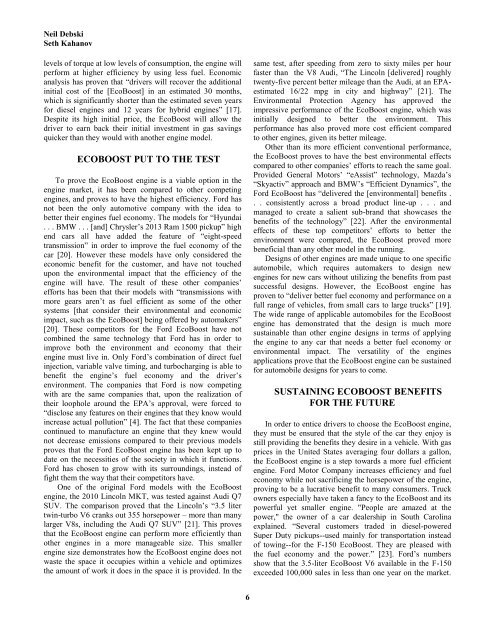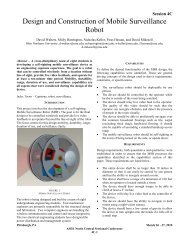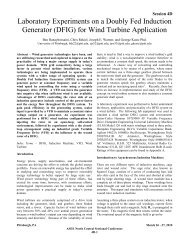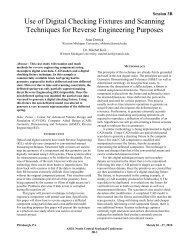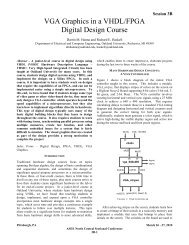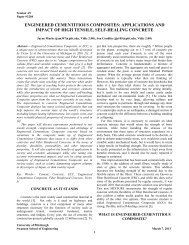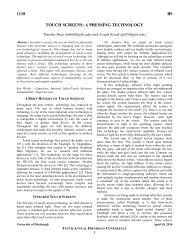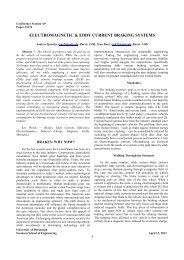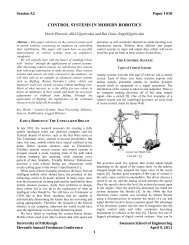THE ECOBOOST ENGINE: COMBINING VARIABLE VALVE TIMING ...
THE ECOBOOST ENGINE: COMBINING VARIABLE VALVE TIMING ...
THE ECOBOOST ENGINE: COMBINING VARIABLE VALVE TIMING ...
You also want an ePaper? Increase the reach of your titles
YUMPU automatically turns print PDFs into web optimized ePapers that Google loves.
Neil Debski<br />
Seth Kahanov<br />
levels of torque at low levels of consumption, the engine will<br />
perform at higher efficiency by using less fuel. Economic<br />
analysis has proven that “drivers will recover the additional<br />
initial cost of the [EcoBoost] in an estimated 30 months,<br />
which is significantly shorter than the estimated seven years<br />
for diesel engines and 12 years for hybrid engines” [17].<br />
Despite its high initial price, the EcoBoost will allow the<br />
driver to earn back their initial investment in gas savings<br />
quicker than they would with another engine model.<br />
<strong>ECOBOOST</strong> PUT TO <strong>THE</strong> TEST<br />
To prove the EcoBoost engine is a viable option in the<br />
engine market, it has been compared to other competing<br />
engines, and proves to have the highest efficiency. Ford has<br />
not been the only automotive company with the idea to<br />
better their engines fuel economy. The models for “Hyundai<br />
. . . BMW . . . [and] Chrysler’s 2013 Ram 1500 pickup” high<br />
end cars all have added the feature of “eight-speed<br />
transmission” in order to improve the fuel economy of the<br />
car [20]. However these models have only considered the<br />
economic benefit for the customer, and have not touched<br />
upon the environmental impact that the efficiency of the<br />
engine will have. The result of these other companies’<br />
efforts has been that their models with “transmissions with<br />
more gears aren’t as fuel efficient as some of the other<br />
systems [that consider their environmental and economic<br />
impact, such as the EcoBoost] being offered by automakers”<br />
[20]. These competitors for the Ford EcoBoost have not<br />
combined the same technology that Ford has in order to<br />
improve both the environment and economy that their<br />
engine must live in. Only Ford’s combination of direct fuel<br />
injection, variable valve timing, and turbocharging is able to<br />
benefit the engine’s fuel economy and the driver’s<br />
environment. The companies that Ford is now competing<br />
with are the same companies that, upon the realization of<br />
their loophole around the EPA’s approval, were forced to<br />
“disclose any features on their engines that they know would<br />
increase actual pollution” [4]. The fact that these companies<br />
continued to manufacture an engine that they knew would<br />
not decrease emissions compared to their previous models<br />
proves that the Ford EcoBoost engine has been kept up to<br />
date on the necessities of the society in which it functions.<br />
Ford has chosen to grow with its surroundings, instead of<br />
fight them the way that their competitors have.<br />
One of the original Ford models with the EcoBoost<br />
engine, the 2010 Lincoln MKT, was tested against Audi Q7<br />
SUV. The comparison proved that the Lincoln’s “3.5 liter<br />
twin-turbo V6 cranks out 355 horsepower – more than many<br />
larger V8s, including the Audi Q7 SUV” [21]. This proves<br />
that the EcoBoost engine can perform more efficiently than<br />
other engines in a more manageable size. This smaller<br />
engine size demonstrates how the EcoBoost engine does not<br />
waste the space it occupies within a vehicle and optimizes<br />
the amount of work it does in the space it is provided. In the<br />
same test, after speeding from zero to sixty miles per hour<br />
faster than the V8 Audi, “The Lincoln [delivered] roughly<br />
twenty-five percent better mileage than the Audi, at an EPAestimated<br />
16/22 mpg in city and highway” [21]. The<br />
Environmental Protection Agency has approved the<br />
impressive performance of the EcoBoost engine, which was<br />
initially designed to better the environment. This<br />
performance has also proved more cost efficient compared<br />
to other engines, given its better mileage.<br />
Other than its more efficient conventional performance,<br />
the EcoBoost proves to have the best environmental effects<br />
compared to other companies’ efforts to reach the same goal.<br />
Provided General Motors’ “eAssist” technology, Mazda’s<br />
“Skyactiv” approach and BMW’s “Efficient Dynamics”, the<br />
Ford EcoBoost has “delivered the [environmental] benefits .<br />
. . consistently across a broad product line-up . . . and<br />
managed to create a salient sub-brand that showcases the<br />
benefits of the technology” [22]. After the environmental<br />
effects of these top competitors’ efforts to better the<br />
environment were compared, the EcoBoost proved more<br />
beneficial than any other model in the running.<br />
Designs of other engines are made unique to one specific<br />
automobile, which requires automakers to design new<br />
engines for new cars without utilizing the benefits from past<br />
successful designs. However, the EcoBoost engine has<br />
proven to “deliver better fuel economy and performance on a<br />
full range of vehicles, from small cars to large trucks” [19].<br />
The wide range of applicable automobiles for the EcoBoost<br />
engine has demonstrated that the design is much more<br />
sustainable than other engine designs in terms of applying<br />
the engine to any car that needs a better fuel economy or<br />
environmental impact. The versatility of the engines<br />
applications prove that the EcoBoost engine can be sustained<br />
for automobile designs for years to come.<br />
SUSTAINING <strong>ECOBOOST</strong> BENEFITS<br />
FOR <strong>THE</strong> FUTURE<br />
In order to entice drivers to choose the EcoBoost engine,<br />
they must be ensured that the style of the car they enjoy is<br />
still providing the benefits they desire in a vehicle. With gas<br />
prices in the United States averaging four dollars a gallon,<br />
the EcoBoost engine is a step towards a more fuel efficient<br />
engine. Ford Motor Company increases efficiency and fuel<br />
economy while not sacrificing the horsepower of the engine,<br />
proving to be a lucrative benefit to many consumers. Truck<br />
owners especially have taken a fancy to the EcoBoost and its<br />
powerful yet smaller engine. "People are amazed at the<br />
power," the owner of a car dealership in South Carolina<br />
explained. “Several customers traded in diesel-powered<br />
Super Duty pickups--used mainly for transportation instead<br />
of towing--for the F-150 EcoBoost. They are pleased with<br />
the fuel economy and the power.” [23]. Ford’s numbers<br />
show that the 3.5-liter EcoBoost V6 available in the F-150<br />
exceeded 100,000 sales in less than one year on the market.<br />
6


